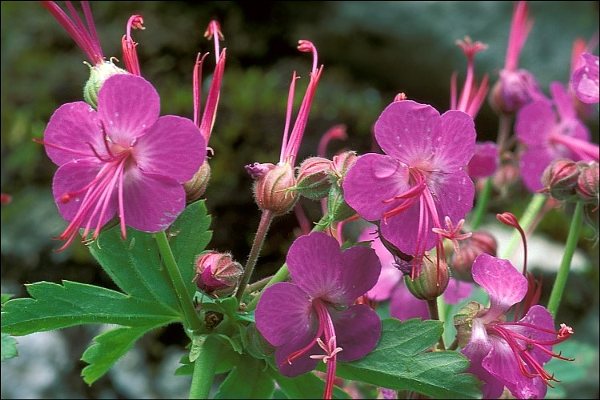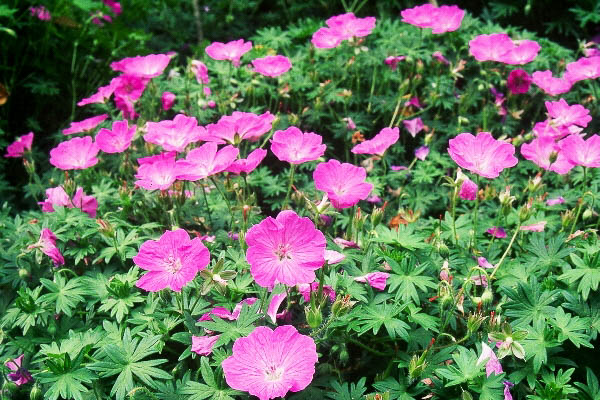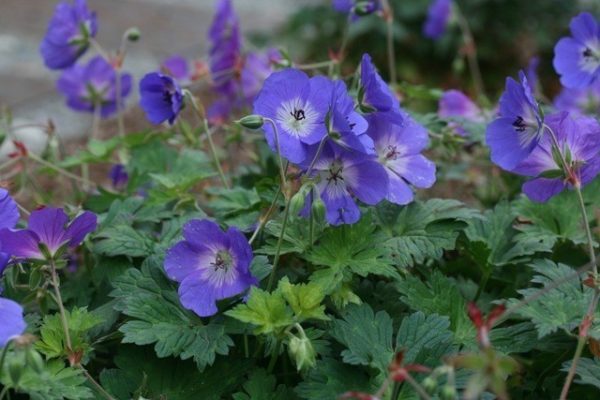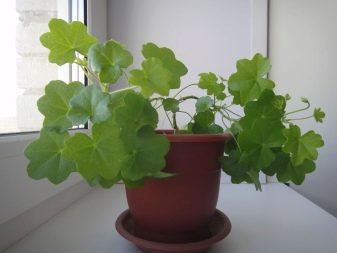Reproduction methods and rules
Ampelous geraniums are propagated in two ways - by seeds and cuttings. The second method is considered more effective - when cuttings, the characteristics of the variety are fully preserved. Growing from seed is laborious. The use of seeds collected from your plant does not always give good results.
Seeds
Peculiarities. For growing geraniums, it is better to use seeds purchased from specialized stores. This method is more suitable for obtaining a new variety, rather than propagation. It is not customary to propagate hybrid species by seed. Geraniums are sown in December so that by spring the seedlings have already started to grow. It is advisable to use artificial lighting at the stage of germination and the beginning of sprout development.
Algorithm of action
- A shallow wide container is filled with a soil mixture consisting of sand, peat, sphagnum and garden soil.
- Seeds are spread over the surface at a short distance from each other. Sprinkle with a layer of soil up to 5 mm.
- The soil is moistened, the container is covered with foil. Place in a warm place under fluorescent lamps.
The first shoots appear within a week. The conditions of detention do not change until the moment of picking. It will be possible to plant seedlings in separate pots in about a month, after the appearance of three real leaves.
By cuttings
Peculiarities. It is easy to propagate ampelous geranium by cuttings. They take root easily, grow quickly. Cutting time is combined with autumn or spring pruning. The tops of the shoots are used as planting material.
Algorithm of action
- Cut the cuttings no more than 12 cm long. The lower leaves are removed.
- Cuttings are dried for two hours, dipped in coal powder and planted directly into light soil containing peat and sphagnum. Geranium cuttings often rot in water.
- They are kept warm, in the light, under a cap made of a cut plastic balloon. The soil is regularly moistened, avoiding the ingress of water on the stem.
- After signs of growth appear, the main stem is pinched to stimulate lateral branching.
If it is not possible to root the ampelous geranium, before planting, treat the cuttings with a root formation stimulator "Kornevin", "Heteroauxin". The roots will appear much faster.
Judging by the reviews, geranium cannot be propagated with a leaf. In theory, a leaf can take root, but it will take a long time and success is not guaranteed. Therefore, leaf propagation is not used.
Types, varieties
Garden geranium, unpretentious to growing conditions, depending on the species, can be tall or undersized, it differs not only in size, but also in the color of flowers. You can choose a bush suitable for a flower garden or rockery, choosing from several varieties. The following perennial varieties of street pelargonium are most popular with gardeners.
Balkan (large rhizome). It has a thick branched rhizome, the bush grows up to 30 cm. The leaves are long, dark green, in autumn they acquire a yellow-red hue. Peduncles are long, inflorescences are red or purple in color. In the photo below, you can see the shape of the flowers in close-up.

- Georgian. An unpretentious herbaceous shrub that grows in one place for up to 10 years. Abundant flowering, bright purple inflorescences.
- Swamp. Differs in medium-sized purple flowers, branched erect stems 50-70 cm high. The bush remains compact, blooms all summer. In August, small seeds ripen, the variety multiplies by self-sowing.
- Blood red. Differs in abundant flowering, bright red flowers reach a diameter of 4 cm.The spherical bush grows up to 60 cm, the leaves are light green, with a dissected pattern, turn red in the fall. Flowering lasts all summer. The photo shows a blood-red pelargonium bush in all its glory.

- Himalayan (large-flowered). The bushes reach a height of 30-50 cm, leaves with rounded edges grow up to 10 cm long. The flowers are large, about 5 cm in diameter, purple, with bright reddish veins.
- Gorgeous. Large-flowered species, blooms from May to June with blue-violet flowers. The height of the bush is 40-60 cm, in autumn the green leaves turn red.
- Variety "Summer sky". An unusually spectacular variety with large double flowers of a blue color, about 3 cm in diameter. Abundant flowering, the bush reaches a height of 50-60 cm.
- Meadow. It looks like a dense bush, reaches a height of 120 cm. Lilac-blue flowers appear in the middle of summer, do not flourish until autumn. The photo shows a close-up of the blooming health resort on a grassy meadow.

Features of home care
There are no fundamental differences in caring for tulip geraniums from other types of geraniums.
Temperature
Pelargonium tulip prefers a warm atmosphere, the optimum temperature for keeping it in the summer will be 21 ... 26 ° С. She can easily tolerate higher temperatures, but provided that the soil in the pot does not dry out.
Attention! In winter, during the rest of the plant, the temperature should be lowered to 15 ° C.
The soil
Geranium loves fertile, loose soils that do not interfere with free gas exchange. You can buy a suitable substrate from a flower shop or make your own. Mix:
- one part of sand;
- two parts of humus;
- two parts of peat;
- two pieces of leafy land.
Fertilizer
It is better to add the first nitrogen complexes in the second half - end of February, shortly before the buds appear. To increase the flowering period, it is better to add potassium-phosphorus mineral complexes.
Immediately after transplanting into a new pot, the plant should not be fed either - the fresh substrate contains enough nutrients for the development of geraniums.
Important! In the winter months, during which the dormant period of the bush falls, it is strictly forbidden to apply fertilizers - this will not allow the geranium to gain enough strength to release new flower stalks, since it will not rest in winter.
Dry air
Pelargonium reacts poorly to spraying, they are recommended only to prevent the appearance of parasites and the development of diseases.
It is also not worthwhile to additionally humidify the air around the geranium, it receives all the moisture it needs from the soil. But watering should be carried out often (once every 2-3 days) and do not allow the earth to dry out.
Lighting
Geranium is photophilous, but does not tolerate constant contact with sunlight. For a good vegetation, a couple of hours in the open sun is enough for her, the rest of the time only diffused bright light should fall on the bush.
What is needed for flowering
In order for the bush to please with long flowering, it is important:
- Pick up a pot. It should be slightly larger than the root system, but not too spacious, otherwise the pelargonium will use all its forces to fill the space of the pot with roots.
- Provide a loose, breathable, nutritious soil mixture.
- Make top dressing in a timely manner.
- Cut off the bush.
- Give Pelargonium time to rest in winter.
Pruning and shaping the bush
Pruning is carried out before the geranium begins to bloom, but no later than March, otherwise the appearance of peduncles can be greatly delayed.
Formative pruning is usually carried out, its purpose is to form a beautiful bush shape. Usually the cut is made at the level of 7–8 leaves with a sterile sharp knife.
Attention! Dwarf varieties are allowed to pinch, since they practically do not grow over the winter.
Transfer
Tulip geranium painfully tolerates transplants, so they should not be carried out too often and only when it is really necessary.
For example, the pot has ceased to accommodate an overgrown bush, the plant is affected by diseases or has undergone an invasion of pests.
Growing problems, diseases and pests
Geranium is not immune to disease. The main signs of flower ailments:
- The appearance of white circles on geranium leaf plates. This is the first sign of rust.
- Gray loose spots on the lower part of the leaf. This symptom indicates infection with gray mold.
- Stems and leaves take on an unhealthy red hue if the flower is frozen.

Signs of geranium diseases
Pelargonium is most often affected by the following pests:
- whitefly butterfly;
- spider mite;
- mealy worm.
Remember! When the first signs of the disease appear, treatment is urgently needed.
How to deal with them
In case of an invasion of any harmful insects, treatment with soapy water or spraying with insecticides will help save the plant. The most effective remedies:
- Fitoverm;
- Fufa-Nova;
- Aktara.
Means of a new generation perfectly protect flowers, not only as a preventive measure, but even during the period of illness. If signs of disease are found, it is imperative to remove all infected leaves.

Pelargonium tulip
The tulip subspecies of geranium requires care and attention, but compliance with all the rules will invariably allow you to grow a beautiful flower with the most abundant flowering. Huge caps of inflorescences of this amazing species will not leave anyone indifferent.
Description
Only one culture belongs to the ampelous species of pelargonium. This is the thyroid (ivy) pelargonium. She recently came to the houses and gardens of Russian flower growers. Prior to this, the culture lived only in its natural environment (in the tropics of Africa). All varieties of this group have flexible and rather long shoots. They form beautiful hanging cascades up to 1 m long. That is why they are often used to decorate hanging compositions and are grown in tall flowerpots in areas.
The leaves are harsh and have a relatively smooth surface. The color is usually green. Some varieties stand out for their interesting foliage color (light spots on a dark background). The leaves are quite large (up to 6 cm).


The flowers are collected in umbellate inflorescences, the size of which can exceed 9 cm. Each of them can have up to 40 buds. Flowers may look different depending on the variety. The petals can be simple or double. The shape of the flowers can resemble stars, lush peonies, roses.
The palette of shades is also varied. These are soft and bright pink, red, burgundy, lilac tones. Of course, there are also representatives of the flora with snow-white flowers in the assortment of varieties. The color can be monochromatic, or it can combine several different shades. The most common options are with a contrasting border on the petals. Flowering begins in spring and pleases crop owners until late autumn.
Geranium flower care
This unpretentious luxury culture requires minimal, but proper care. Only in this way will she please with bright and lush bouquets.
Plant care and basic rules:
- a lot of sun. Do not be afraid to place the pot of geraniums in direct sunlight, except on especially hot days. At this time, you just need to cover it to avoid burning the leaves;
- hard water for irrigation is unacceptable. In winter, the plant is watered 2 times a week, avoiding getting on the leaves, and in summer it is moderate, but every day;
- drainage at the bottom of the pot is a prerequisite so that there is no stagnation of water;
- small pot. This is necessary for the plant to completely fill it with roots;
- do not spray or rinse foliage. Excessive moisture is dangerous for this crop;
- it is worth considering carefully the choice of soil. Be sure to need a 1: 1: 1 mixture of peat, sand and garden soil;
- it is required to loosen the earth more often. The roots must be fed with oxygen;
- do not forget to feed the culture. Geranium should receive mineral fertilizers (phosphorus and potassium).This beauty does not accept organic fertilizers;
- nitrogen feeding. This is done necessarily after flowering and only once a week from April to September.
These are the main conditions under which the plant will delight with its beauty and dense flowering.
Note! If the apartment is on the shady side, then you can add some artificial light for the plant. Reproduction of the culture is carried out mainly by cuttings (the most reliable way), but it is also possible with leaves
It is best to do this in the spring (March-April is the ideal time)
Reproduction of the culture is carried out mainly by cuttings (the most reliable way), but it is also possible with leaves. This is best done in the spring (March-April is the ideal time).
Choosing a location for geraniums
The flower feels very comfortable and well on the windowsill, on the balcony or on the veranda (open air is good for culture), but only on the south side. The most optimal temperature for him is room temperature, because this way he feels comfortable.
Choosing a place for geranium
In the warm season, the flower pot can be taken out to the veranda or balcony, fresh air will have a positive effect on its development
It is important to remember that the plant does not like drafts.
Air humidity
As noted above, this crop does not like spraying, but this does not mean that it is not necessary to maintain optimal indoor humidity. Below is a table showing the required humidity and air temperature for growing geraniums.
table
If geranium is adjacent to other indoor plants that need to be sprayed, then it is worth protecting it from moisture when other flowers are irrigated.


